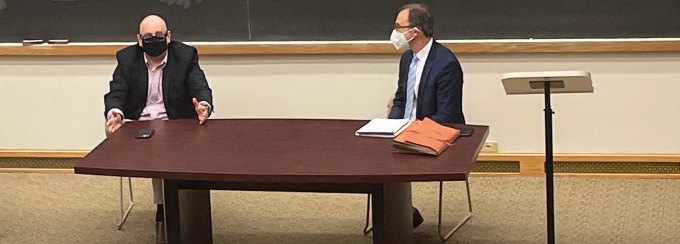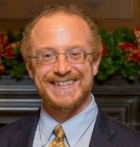
Charles Malcomb ’09 joins Jeff Stravino '97's class to offer insight on New York State environmental statutes. Both attorneys are partners in the Buffalo office of Hodgson Russ LLP.
Expert practitioners teach courses on the intricacies of environmental law
UB Law students concerned about the environment—or hoping to make environmental law part of their professional life—have found the spring semester rich with academic possibility including three one-credit courses, taught by adjunct faculty members with deep experience in the field.
The seminar courses, each of which covers four three-hour class sessions, are designed to provide students with the tools they’ll need as lawyers and environmental advocates. In addition to the practitioners who are teaching them, they feature guest lecturers who bring their own perspectives on the need for skilled advocacy in this area.

Jeffrey C. Stravino ’97
Jeffrey C. Stravino ’97 practices business litigation and environmental law as a partner in the Buffalo office of Hodgson Russ LLP. His course, New York Environmental Law Basics, which ended at the end of February, provided an overview of New York environmental law including the Environmental Conservation Law, New York Code of Rules and Regulations, and policies issued by the New York State Department of Environmental Conservation (DEC). The course also explored the role of the DEC, the Department of Health, the New York State Attorney General, and what it is like to practice as an environmental attorney.
Stravino invited guest speakers to two classes to discuss environmental due diligence in transactions, compliance, land use, permitting, and environmental review. The course also highlighted the impact that Love Canal has had on state and federal environmental laws. For example, he says, the students worked on an assignment concerning the village of Hoosick Falls, south of Albany, where harmful forever chemicals were discovered in its drinking water. A legal settlement with the companies that caused the problem will fund a major cleanup and improvements to water treatment there.
“There’s been a resurgence of interest in environmental law, because people realize the impact the environment can have on our everyday lives,” says Stravino, who’s also the current president of the UB Law Alumni Association.
The federal statutes around environmental quality may be better-known, Stravino says, but New York has developed its own set of regulations largely through the Department of Environmental Conservation. He says the state’s brownfield remediation program has been especially active and utilized to clean up and redevelop sites downstate and in Buffalo, Rochester, and Niagara Falls, including the Buffalo Niagara Medical Campus, Canalside, Larkinville, the Old First Ward, and along Niagara Street.
The students, Stravino says, came from varied backgrounds, making for a rich mix. “It was refreshing to be in a class with students who clearly wanted to learn and were interested,” he says. “I’ve been very impressed with the level of attention to detail in the work I’ve received in response to my assignments.”

Thomas L. Tyler
When Thomas L. Tyler drives up from Virginia in April for his class called Follow the Money and the Molecules, he’ll pass near the Cuyahoga River, and he’ll be sure to tell his class the story: how the river once was so polluted that it repeatedly caught fire, until a major cleanup brought the waterway back to health.
It’s an object lesson in how legal advocacy can do major good. Tyler, who’s chief of staff for the Office of Chemical Safety and Pollution Prevention at the federal Environmental Protection Agency, will explore with his students the ways environmental law intersects with other major areas of law, including real estate, banking, and finance, corporate, energy, international and even civil rights laws.
That confluence of laws is apparent in another example of remediation close to home: the Love Canal neighborhood of Niagara Falls, where toxic sludge sickened hundreds of residents in the 1970s until the site was cleaned up in a major Superfund operation. That episode, he says, connects environmental law with laws governing property, contracts, finance, torts and health.
But more broadly, he says, “I plan to make a point of teaching the course in a way that gives lessons about environmental law and how administrative law works, but also how to be a lawyer in general—how to argue your point, how laws get made, how to appeal, how to work with administrative agencies, how federal, state, and local laws interact. Environmental law gives you ways to demonstrate this.”

Richard Lippes ’69
There are plenty of local examples as well in a course on Historic Preservation Laws taught by Richard Lippes ’69. The recent controversy around whether to demolish a landmark downtown grain elevator, damaged by wind, is a case in point.
Lippes, who handles environmental litigation matters as a partner with Lippes and Lippes in Buffalo, says historic preservation work deals with the built environment and entails working with many of the same agencies as other environmental cases. For example, he says, another local issue—whether to site a major concert venue on Buffalo’s Outer Harbor—involves the environmental impact review process and similar regulations.
Lippes says the course covers historic preservation laws on the federal, state, and local levels. “To some extent, local laws give you the best protection and federal laws give you the least protection,” he says.
Buffalo’s Historic Preservation Ordinance empowers the local preservation board to propose conferring landmark status on historic buildings, with the Common Council having the final say. Once granted, he says, that status affords certain protections to the building, except if emergency demolition is needed.
Most of the students in the seminar are from Western New York, Lippes says, or they’re third-year law students, so they’ve been here for a while—and they’re familiar with the rich architectural heritage that historic preservation laws are designed to protect.